Resistance bands CAN be extremely effective for helping you master the pull-up. But only if you choose the right weight, length, and thickness. This post explains what size resistance bands you need for pull-ups.
The ideal resistance band size for pull-ups measures around 38-42″ in length and 0.15-0.30″ in thickness. The band should provide between 30-80lbs of resistance, but this will vary depending on the person’s current fitness level. Beginners and overweight people generally require heavier bands.
It took me months to master my first pull-up.
Then I discovered how beneficial resistance bands could be in achieving my goal.
Below, I’ll share my research and personal experience in choosing the right bands to help you do the same!

- Interested A Pull-Up Band?
- Can Any Resistance Band Be Used For Pull-Ups?
- Ideal Resistance Band Weight For Pull-Ups
- Optimum Resistance Band Length For Pull-Ups
- Best Resistance Band Thickness For Pull-Ups
- How Many Resistance Bands You Need For Pull-Ups
- Recommended Resistance Bands For Pull-Ups
- Recommended Resistance Bands Recap
- Conclusion
Interested A Pull-Up Band?
| Product | Brand | Description | Prime | Buy |
|---|---|---|---|---|
Top Top
Top
Top
Top
Top
Top | Undersun | BEST OVERALL Circular loop band set with 5x weight increments for beginenrs and advanced lifters to build muscle at home (bundled with door anchor and travel pouch) | PrimeEligible | Check Amazon Price |
 Top
Top
Top
Top
Top
Top Top
Top
Top
Top
Top
Top | Iron Infidel | Circular loop band set with 5x weight increments. No door anchor and less durable than Undersun. But a portion of their profits is donated to the Wounded Warriors Foundation for injured war veterans | PrimeEligible | Check Amazon Price |
 Top
Top
Top
Top
Top
Top Top
Top
Top
Top
Top
Top | WODFitters | Budget circular loop bands that can be purchased as single bands | PrimeEligible | Check Amazon Price |
 Top
Top
Top
Top
Top
Top Top
Top
Top
Top
Top
Top | Whatafit | BEST BUDGET tube bands with handles. Cheap and affordable for beginenrs but do not provide the same weight or durability as circular loop bands. | PrimeEligible | Check Amazon Price |
 | Theraband | Alternative bands for seniors. Extremely affordable but light resistance bands for general fitness workouts. | PrimeEligible | Check Amazon Price |
 Top
Top
Top
Top
Top
Top Top
Top
Top
Top
Top
Top | Boss Fitness | Door anchor replacement for unlocking exercise angles to isolate different muscle regions like the upper chest | PrimeEligible | Check Amazon Price |
 Top
Top
Top
Top
Top
Top Top
Top
Top
Top
Top
Top | Ihuan | Ventilated microfibre-neoprene workout gloves to protect hands from friction burns generated by resistance bands | PrimeEligible | Check Amazon Price |
Can Any Resistance Band Be Used For Pull-Ups?
All resistance bands can be used for pull-ups. However, certain types of bands are better suited for the role than others. Circular loop bands are generally the best for providing pull-up assistance due to their durable shape, heavy resistance levels, optimal length, and superior thickness.
Here are examples of the best circular loop resistance bands for pull-ups:
- Undersun Fitness loop exercise band set. (my personal recommendation, you can find the cheapest price here).
- REP Fitness circular loop bands for pull-ups.
- Set For Set circular loop band set.
- Iron Bull circular loop bands
- Rogue Monster Bands.
- Fit Simplify individual pull-up assist bands.
- Veick circular resistance bands.
- WOD Nation pull-up assistance bands.
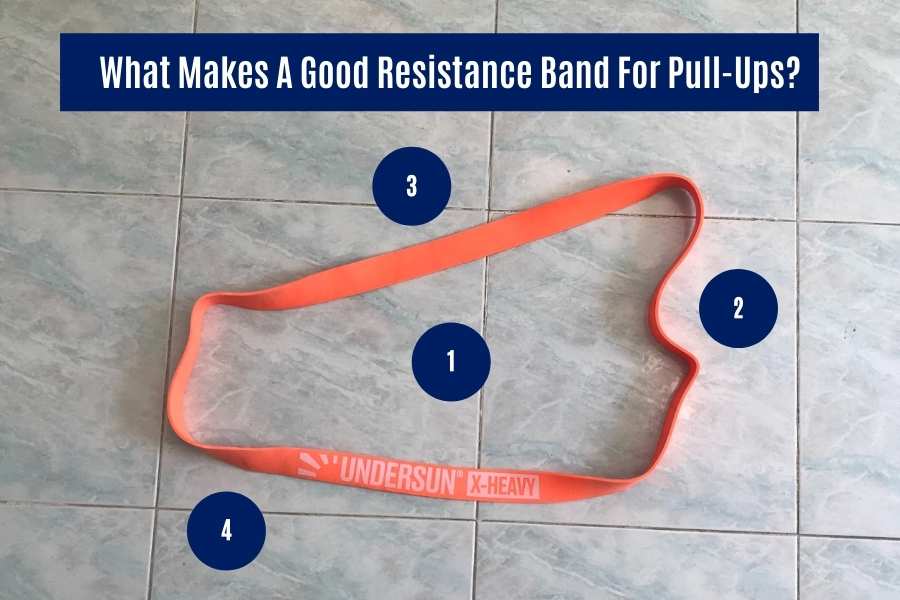
These bands have common characteristics that make them ideal for pull-ups:
- Circular loop shape. A circular piece of continuous rubber is more durable compared to tube bands which have carabiner ends. This makes them more suitable to handle a person’s body weight during pull-ups. The absence of metal carabiners on loop bands also reduces the risk of damaging your pull-up bar.
- Heavy resistance. A heavy tolerance is essential to ensure your resistance bands don’t snap during a pull-up (yes bands can snap!). But your bands shouldn’t be so heavy that it provides too much assistance either.
- Optimal length. The size of your resistance bands should be long enough to comfortably wrap around the bar and your buttocks/thighs during pull-ups. If it’s too long, it won’t provide enough assistance. If it’s too short, it’ll provide too much assistance.
- Superior thickness. Thicker size resistance bands are more able to take the stress and abuse associated with assisted pull-ups. Remember, you’re twisting and knotting the band around a bar!
Ideal Resistance Band Weight For Pull-Ups
Beginners are recommended to use medium-heavy weight resistance bands for assisted pull-ups. These typically provide between 30-80lbs of assistance. Overweight individuals generally require more assistance, whilst trained people typically require less.
Here’s a breakdown of what resistance band weight you need according to your fitness levels:
| Resistance Band Weight Classification | Resistance Level | Band Width | Recommended For: |
|---|---|---|---|
| Extra-light | 5-15lbs | 0.25-0.50 inch | Advanced trainees who want to increase pull-up reps and range of motion. |
| Light | 15-25lbs | 0.50-0.75 inch | Intermediates who can only do 3-6 unassisted pull-ups |
| Medium | 30-60lbs | 0.75-1.25 inch | Beginners who can only do 1-2 unassisted pull-ups. |
| Heavy | 40-80lbs | 1.25-1.75 inch | Novices who weigh more than 200lbs and cannot do unassisted pull-ups. |
| Extra-heavy | 50-120lbs | 1.75-2.25 inch | Overweight novices who cannot do unassisted pull-ups. |
- Extra light bands. These are great for someone who can already perform unassisted bodyweight pull-ups but want to build their endurance to complete more reps per set. They’re also good to help advanced trainees improve their pull-up form, depth, and range of motion. Finally, they can also be used to end a workout with a great pump by doing assisted pull-up reps to failure.
- Light bands. These are ideal for someone who can already do unassisted pull-ups with good form but has reached a plateau and want to increase their reps to around 10-15 per set.
- Medium bands. Resistance bands at this size are great for beginners who can already do a couple of pull-ups but want to increase their reps, improve form, and still get a good workout along the way.
- Heavy bands. If you’re a heavy person and struggling to do unassisted pull-ups, then resistance bands at this size are enough to safely assist your body weight and help you to improve your pulling power/stamina.
- Extra-heavy bands. As per above but for overweight people!
Optimum Resistance Band Length For Pull-Ups
Resistance bands should ideally measure 38-42 inches in length for pull-ups assistance. This is the optimal length to loop the band around a bar and the body. Longer bands may not provide enough assistance, whilst shorter bands may provide too much assistance.
Take a look at the pic below to be clear on what the “length of a resistance band” is and how it’s measured:
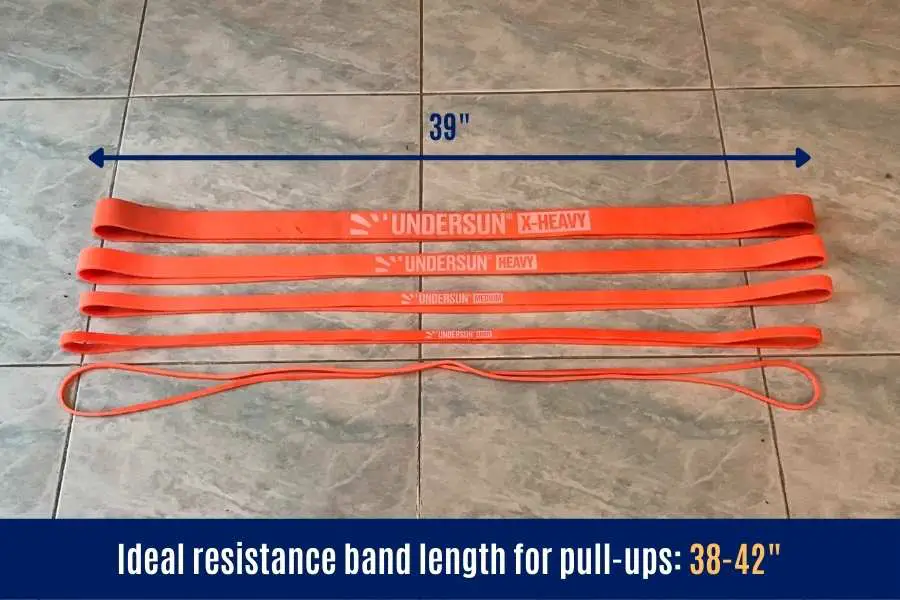
Note that this is only a recommendation.
If the length of your bands is off by a couple of inches, it won’t be a disaster.
Just try your best to make sure the size of your resistance bands is as close to this recommendation as possible to provide the best assistance for pull-ups.
Remember that a band can typically stretch 2-3 times its resting length.
The band only provides assistance when it stretches. That’s why it can’t be too long (your feet will touch the floor before the band has the chance to assist).
Likewise, an overstretched band might provide too much assistance. And that’s why it can be too short (there’s no point doing the pull-up if it’s not challenging!).
Best Resistance Band Thickness For Pull-Ups
The best resistance bands for pull-ups have a 0.15-0.30 inch thickness. This provides enough durability to handle the mechanical stresses associated with wrapping the band around a bar and stretching during pull-up assistance. A thicker band will generally last longer and is therefore better.
Take a look at the below pic for a better idea of what I mean by resistance band thickness:
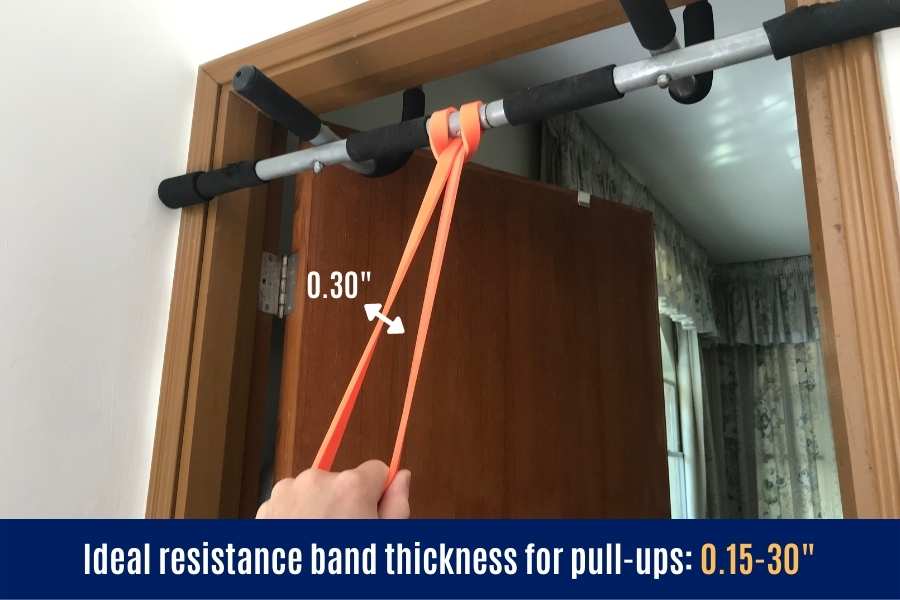
Remember, a resistance band is usually looped and twisted around the bar during pull-up assistance.
This alone presents a lot of mechanical stress.
But the issue is further compounded by the fact that the band is being stretched by your body weight during pull-up assistance.
Therefore it’s important to consider thickness– not just length and weight- when choosing the best size resistance bands for pull-ups.
Thicker is usually better.
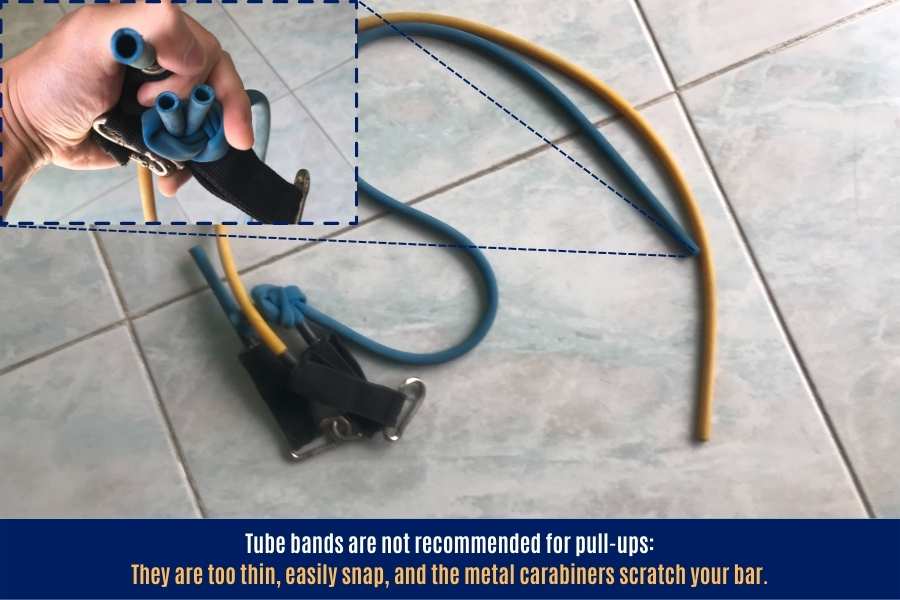
One word of caution- be careful with those budget tube bands on Amazon (the ones with the handle attachments).
These may look thick, but they are usually hollow inside and actually quite thin.
They snap in no time.
I much prefer to spend a bit extra on premium bands like these Undersuns (link for the cheapest price), which will last me the entire duration of my pull-up progression (and more)
How Many Resistance Bands You Need For Pull-Ups
Generally speaking, a single resistance band is enough for assisted pull-ups. However, it can be extremely beneficial to have a set of 3-5 bands at different resistance levels. Different combinations can provide varying degrees of assistance to accommodate for future strength progression.
Here’s what a smooth pull-up progression could look like using a set of bands each offering a different resistance level:
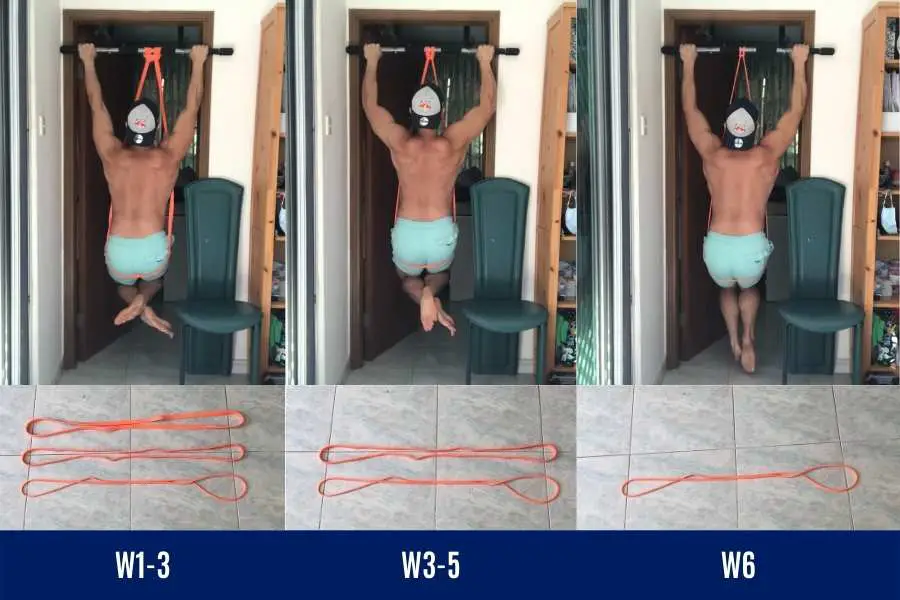
You would typically begin assistance with multiple bands during your first few weeks of training.
Using 3 lighter bands rather than a single heavy band is beneficial because it’s better to spread mechanical stress over multiple bands than it is to concentrate it all on one band. Your bands will last longer.
It’s also easier to fine-tune the assistance using multiple bands versus using a single band.
You would then work towards using a single band, and eventually no band, as you become stronger.
The example progression allows for a smooth transition from not being able to do a pull-up, all the way to mastering your first unassisted pull-up.
You can see that this progression simply can’t be achieved with a single band since you don’t have access to the same resistance increments.
Besides, a set of resistance bands doesn’t cost that much more than a single band!
Unconvinced about how effective resistance bands can be? You can check out my other post for 5 before and after resistance band transformations for inspiration!
Recommended Resistance Bands For Pull-Ups
I’ve been using the Undersun Fitness bands for 3 years now and can’t recommend them enough.
They come as a set of 5 bands ranging from 5 to 150lbs of resistance.
This makes them great for pull-up assistance no matter what training level you are (it also means they’re future-proof as you become stronger).
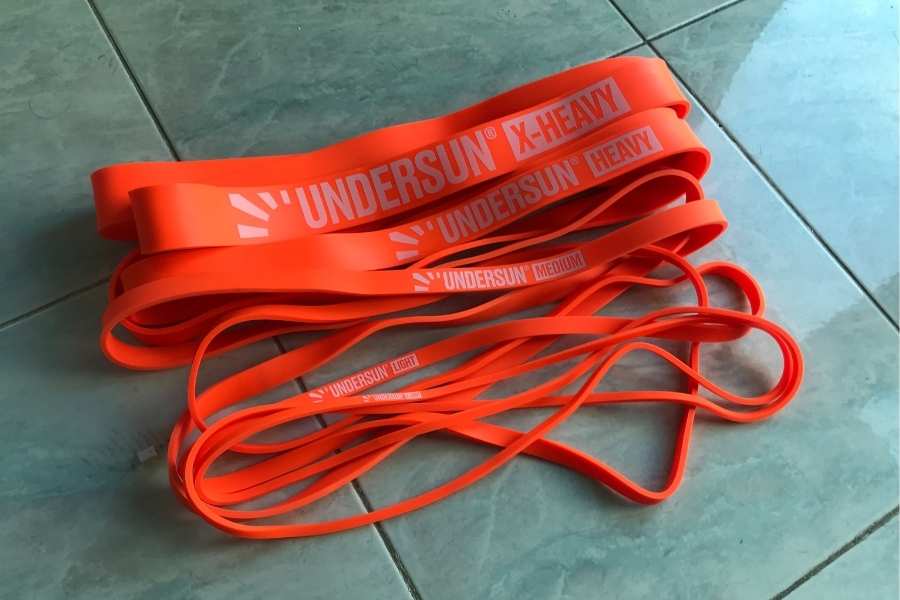
These resistance bands are 39″ long and 0.30″ thick, making them the ideal size for pull-ups.
Having gone through multiple sets of cheap bands in the past (all of which snapped), i can say these are one of the most durable bands out there.
They also come with a much-sought lifetime warranty.
This is a nice bonus considering most bands take a lot of abuse from assisted pull-ups!
You can get the Undersun bands delivered quickly and cheaply here.
Recommended Resistance Bands Recap
| Product | Brand | Description | Prime | Buy |
|---|---|---|---|---|
Top Top
Top
Top
Top
Top
Top | Undersun | BEST OVERALL Circular loop band set with 5x weight increments for beginenrs and advanced lifters to build muscle at home (bundled with door anchor and travel pouch) | PrimeEligible | Check Amazon Price |
 Top
Top
Top
Top
Top
Top Top
Top
Top
Top
Top
Top | Iron Infidel | Circular loop band set with 5x weight increments. No door anchor and less durable than Undersun. But a portion of their profits is donated to the Wounded Warriors Foundation for injured war veterans | PrimeEligible | Check Amazon Price |
 Top
Top
Top
Top
Top
Top Top
Top
Top
Top
Top
Top | WODFitters | Budget circular loop bands that can be purchased as single bands | PrimeEligible | Check Amazon Price |
 Top
Top
Top
Top
Top
Top Top
Top
Top
Top
Top
Top | Whatafit | BEST BUDGET tube bands with handles. Cheap and affordable for beginenrs but do not provide the same weight or durability as circular loop bands. | PrimeEligible | Check Amazon Price |
 | Theraband | Alternative bands for seniors. Extremely affordable but light resistance bands for general fitness workouts. | PrimeEligible | Check Amazon Price |
 Top
Top
Top
Top
Top
Top Top
Top
Top
Top
Top
Top | Boss Fitness | Door anchor replacement for unlocking exercise angles to isolate different muscle regions like the upper chest | PrimeEligible | Check Amazon Price |
 Top
Top
Top
Top
Top
Top Top
Top
Top
Top
Top
Top | Ihuan | Ventilated microfibre-neoprene workout gloves to protect hands from friction burns generated by resistance bands | PrimeEligible | Check Amazon Price |
Conclusion
I’ve explained what size (weight, length, thickness) resistance bands you need for pull-ups assistance.
Ideally, they should provide enough weight to assist pull-ups at YOUR current fitness level (this varies from person to person).
Additionally, they should be around 40″ long and have a 0.15-0.30″ thickness.
Speaking from experience, the best resistance bands for pull-ups are hands-down circular loop bands rather than the cheap tube bands on Amazon.
What size resistance bands will you be getting for your pull-ups?
Feel free to send me a message if you have any questions! You can find my details on the “contact us” page.
You may also be interested in the downloadable Kalibre Blueprint PDF which details exactly how I gained 40lbs of lean muscle (it’s 100% free!). It details the exact exercises and nutrition (with printable worksheets) I used to go from skinny to ripped!
Thanks for reading guys!
Peace Out,
Kal
(Biochemistry BSc, Biomedical Sciences MSc, Ex-Skinny Guy)


